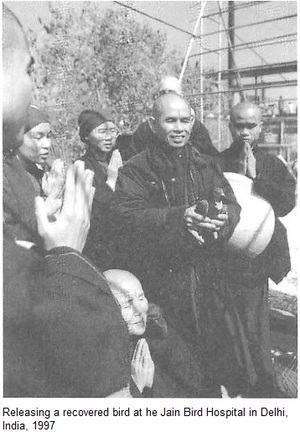By Shantum Seth
One day in Bodhgaya Thay said why don’t we organize the children in the village where Sujata and Svasti used to live. We could have tea meditation there together. I met two kids, one about thirteen or fourteen years old and asked them to get all the children together. I worked with the children over the day. Everyone thought we were absolutely mad to get all these kids together – they thought there would be a riot,
By Shantum Seth
One day in Bodhgaya Thay said why don't we organize the children in the village where Sujata and Svasti used to live. We could have tea meditation there together. I met two kids, one about thirteen or fourteen years old and asked them to get all the children together. I worked with the children over the day. Everyone thought we were absolutely mad to get all these kids together - they thought there would be a riot, because that's what they do when foreigners come, begging and grabbing things. So one evening we all gathered together with 60 or 70 kids in a huge circle and Thay told the story of Sujata and Svasti at the village.
Many of the kids didn't know that story of their own village, and they really liked it. Then we had mango juice meditation. The children were very disciplined, with only a little bit of chaos at the end, but quite nice. The girl who helped gather the children that day has gotten married now and moved to another village, and the boy who helped organize everything that day, he is st ill a friend of mine. His name is Rajesh. I still visit him every time I bring pilgrims; we go to his house. He has three children of his own now. It's a nice continuation from that time.
So we went to all the places associated with the Buddha. We did it very much like a retreat: sitting in the morning, then a talk. It was like a moving retreat. That's how I do it now, just like our retreats here in Plum Village, with sitting and walking meditation, Dharma discussions and so on.
After Bodhgaya we went to Rajgir which is where Vulture Peak is. Most people don't even go to Rajgir but Thay wanted to spend five days there. He loves Vulture Peak. We used to go early in the morning around sunrise and stay will sunset. It was his favorite place. The Buddha built a stone hut there, and it was the place where he supposedly gave the Lohls Sutra and the Heart Sutra. When you go on walking meditation up Vulture Peak, you walk exactly in the path the Buddha walked on. The Buddha used to walk up and down there every day.
Traveling with Thay, I see that he really enjoys himself. He is very free. He loves the Buddha, absolutely loves the Buddha. He knows him very well, like a friend . In fact you can see that in many of his decisions, he refers back to what the Buddha would have done. And with Thay it is not only the historical Buddha that comes alive, also you meet the people the Buddha met, like the young buffalo boy, and the young milk maiden . Suddenly you start to see the Buddha in India now. You reali ze that he crossed this river and the river is still there. Thay helps you to see the Buddha not just as an historical character, but to see him here , now. The most important thing Thay transmitted is that the Buddha is not someone outside of yo u. He is somebody ins ide. Once you've sat under the Bodhi tree, every tree becomes a bodhi tree. Thay really looks with Buddha eyes.
I think the other thing about Thay is his non-discriminating nature. He does seem to have a bit of a bias. He seems to prefer the poor, to enjoy their company more in a sense. But he's very compassionate to all he meets, the rich and the poor. Whether he meets a high official or a street sweeper, he deals with them in the right way, a very nice way. Whether he meets the president or a mother or a boatman, Thay gives dignity to everyone.
I find that now, when I lead new groups, I walk in the footsteps of Thay as much as with the Buddha. For me, the pilgrimage is very much in the footsteps of Thay. Because what he was doing was bringing the Buddha alive as a human being. Thay suggested I offer this trip every year myself. That's how the pilgrimages I offer began. I guess Thay's teacher eyes saw that this was work that suited me.
Shantum Seth, True Path, has been leading pilgrimages to sites of the Buddha's life since 1988. Shantum received the Dharma Lamp transmission in winter 2001.



